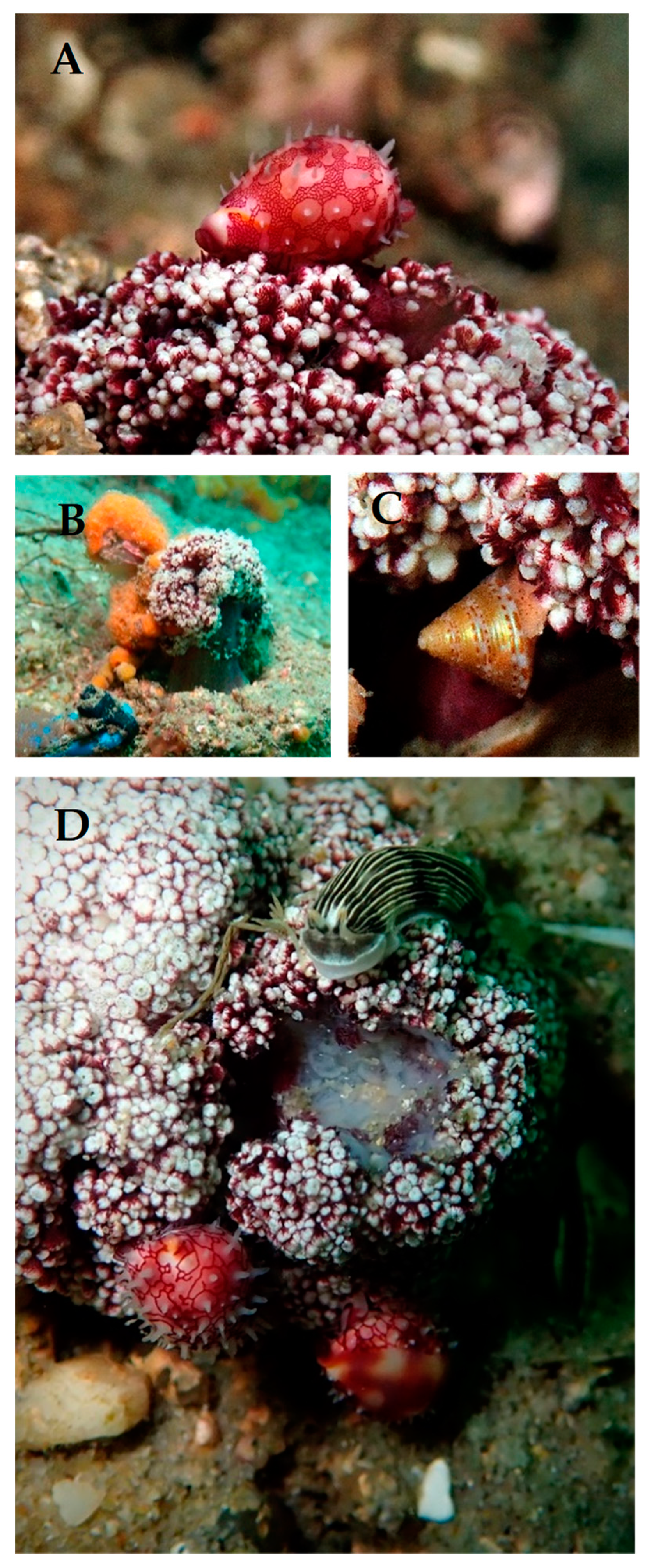If You Plant It, They Will Come: Rapid Recruitment of Habitat-Dependent Marine Invertebrates to Transplanted Fragments of an Endangered Soft Coral Species
Author Contributions
Funding
Institutional Review Board Statement
Acknowledgments
Conflicts of Interest
References
- Clark, S.; Edwards, A. Coral transplantation as an aid to reef rehabilitation: evaluation of a case study in the Maldive Islands. Coral Reefs 1995, 14, 201–213. [Google Scholar]
- Sella, I.; Benayahu, Y. Rearing cuttings of the soft coral Sarcophyton glaucum (Octocorallia, Alcyonacea): Towards mass production in a closed seawater system. Aquac. Res. 2010, 41, 1748–1758. [Google Scholar] [CrossRef]
- Poulos, D.E.; Harasti, D.; Gallen, C.; Booth, D.J. Biodiversity value of a geographically restricted soft coral species within a temperate estuary. Aquat. Conserv. 2013, 23, 838–849. [Google Scholar] [CrossRef]
- Epstein, H.E.; Kingsford, M.J. Are soft coral habitats unfavourable? A closer look at the association between reef fishes and their habitat. Environ. Biol. Fish 2019, 102, 479–497. [Google Scholar] [CrossRef]
- Harasti, D. Declining seahorse populations linked to loss of essential marine habitats. Mar. Ecol. Prog. Ser. 2016, 546, 173–181. [Google Scholar] [CrossRef]
- Larkin, M.F.; Davis, T.R.; Harasti, D.; Cadiou, G.; Poulos, D.E.; Smith, S.D.A. The rapid decline of an endangered temperate soft coral species. Estuar. Coast. Shelf Sci. under review.
- NSW Fisheries Scientific Committee. Fisheries Scientific Committee Determination for Cauliflower Soft Coral (Dendronephthya australis). Department of Primary Industries; 2021. Available online: https://www.dpi.nsw.gov.au/fishing/species-protection/threatened-species-list/endangered-species2/cauliflower-soft-coral (accessed on 14 February 2021).
- Harasti, D.; Martin-Smith, K.; Gladstone, W. Ontogenetic and sex-based differences in habitat preferences and site fidelity of White's seahorse Hippocampus whitei. J. Fish Biol. 2014, 85, 1413–1428. [Google Scholar] [PubMed]
- Davis, T.R.; Harasti, D.; Kelaher, B.; Smith, S.D.A. Spatial and temporal variation in subtidal molluscan diversity amongst temperate estuarine habitats. Mar. Ecol. 2017, 38, e12428. [Google Scholar] [CrossRef]
- Davis, T.R.; Harasti, D.; Smith, S.D.A. Responses of Dendronephthya australis to predation by Dermatobranchus sp. nudibranchs. Mar. Freshw. Res. 2018, 69, 186–190. [Google Scholar] [CrossRef]

Publisher’s Note: MDPI stays neutral with regard to jurisdictional claims in published maps and institutional affiliations. |
© 2021 by the authors. Licensee MDPI, Basel, Switzerland. This article is an open access article distributed under the terms and conditions of the Creative Commons Attribution (CC BY) license (http://creativecommons.org/licenses/by/4.0/).
Share and Cite
Larkin, M.F.; Harasti, D.; Davis, T.R.; Smith, S.D.A. If You Plant It, They Will Come: Rapid Recruitment of Habitat-Dependent Marine Invertebrates to Transplanted Fragments of an Endangered Soft Coral Species. Diversity 2021, 13, 79. https://doi.org/10.3390/d13020079
Larkin MF, Harasti D, Davis TR, Smith SDA. If You Plant It, They Will Come: Rapid Recruitment of Habitat-Dependent Marine Invertebrates to Transplanted Fragments of an Endangered Soft Coral Species. Diversity. 2021; 13(2):79. https://doi.org/10.3390/d13020079
Chicago/Turabian StyleLarkin, Meryl F., David Harasti, Tom R. Davis, and Stephen D. A. Smith. 2021. "If You Plant It, They Will Come: Rapid Recruitment of Habitat-Dependent Marine Invertebrates to Transplanted Fragments of an Endangered Soft Coral Species" Diversity 13, no. 2: 79. https://doi.org/10.3390/d13020079
APA StyleLarkin, M. F., Harasti, D., Davis, T. R., & Smith, S. D. A. (2021). If You Plant It, They Will Come: Rapid Recruitment of Habitat-Dependent Marine Invertebrates to Transplanted Fragments of an Endangered Soft Coral Species. Diversity, 13(2), 79. https://doi.org/10.3390/d13020079






